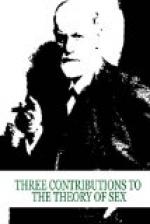It was natural to transfer this conception to the psychic sphere and to conceive the inversion in its aberrations as an expression of psychic hermaphroditism. In order to bring the question to a decision, it was only necessary to have one other circumstance, viz., a regular concurrence of the inversion with the psychic and somatic signs of hermaphroditism.
But this second expectation was not realized. The relations between the assumed psychical and the demonstrable anatomical androgyny should never be conceived as being so close. There is frequently found in the inverted a diminution of the sexual impulse (H. Ellis) and a slight anatomical stunting of the organs. This, however, is found frequently but by no means regularly or preponderately. Thus we must recognize that inversion and somatic hermaphroditism are totally independent of each other.
Great importance has also been attached to the so-called secondary and tertiary sex characters and their aggregate occurrence in the inverted has been emphasized (H. Ellis). There is much truth in this but it should not be forgotten that the secondary and tertiary sex characteristics very frequently manifest themselves in the other sex, thus indicating androgyny without, however, involving changes in the sexual object in the sense of an inversion.
Psychic hermaphroditism would gain in substantiality if parallel with the inversion of the sexual object there should be at least a change in the other psychic qualities, such as in the impulses and distinguishing traits characteristic of the other sex. But such inversion of character can be expected with some regularity only in inverted women; in men the most perfect psychic manliness may be united with the inversion. If one firmly adheres to the hypothesis of a psychic hermaphroditism, one must add that in certain spheres its manifestations allow the recognition of only a very slight contrary determination. The same also holds true in the somatic androgyny. According to Halban, the appearance of individual stunted organs and secondary sex characters are quite independent of each other.[10]
A spokesman of the masculine inverts stated the bisexual theory in its crudest form in the following words: “It is a female brain in a male body.” But we do not know the characteristics of a “female brain.” The substitution of the anatomical for the psychological is as frivolous as it is unjustified. The tentative explanation by v. Krafft-Ebing seems to be more precisely formulated than that of Ulrich but does not essentially differ from it. v. Krafft-Ebing thinks that the bisexual predisposition gives to the individual male and female brain centers as well as somatic sexual organs. These centers develop first towards puberty mostly under the influence of the independent sex glands. We can, however, say the same of the male and female “centers” as of the male and female brains; and, moreover, we do not even know whether we can assume for the sexual functions separate brain locations ("centers”) such as we may assume for language.




